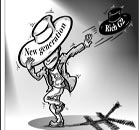Opinion
Debate: China model
(China Daily)
Updated: 2010-03-01 14:33
 |
Large Medium Small |
Two experts debate whether China has a development model, what this model holds for the future and whether the nation needs to retool its development pattern.
Zheng Yongnian: The paradigm and its future
In 2009, Chinese Premier Wen Jiabao stressed during a speech at Cambridge University that China has been a "learning state" since its reform and opening-up. "Learning" in this context has two connotations. It refers to learning from all countries around the world. China has been eagerly learning from international experiences, from large countries like the US to small countries like Singapore. Though criticisms from the West will always exist, they have never dampened China's enthusiasm to learn. Learning also refers to drawing upon China's own experiences, positive or negative.
Over the years, China has built its own economic development model. It is a model of a mixed economy with the co-existence of different forms of ownership and with the government playing a balanced role of "invisible " and "visible hands." For thousands of years, China had a strong state sector and an equally strong non-state sector. The government played an important role through the state sector, especially during economic crises and in building up large infrastructures for the economy. This tradition remains today. The strength of the state sector was demonstrated during the 1997 Asian financial crisis and the 2008-9 global financial crisis.
Without a strong state sector, it would be impossible for China to cope with the crises so effectively. China's political model is equally important for the country's success. It has been effectively coordinating economic and political reforms to provide minimum social and political order for its economic activities. It is also building a socio-economic infrastructure for democratization.
Up until today, China's political and economic system has yet to be perfected, and the "China model" is evolving based on world and Chinese experiences. The model is still in the process of development and based on life experiences and lessons learnt. For example, while the financial crisis had led to a rapid expansion of the state sector, the government has had to channel more resources to the non-state sector. China's history shows that a crisis will ensue if the state sector becomes overwhelmingly dominant.
In the last 30 years, it was economic development at all costs for China. Within a short period of time, China has created an economic miracle, lifting hundreds of millions of people out of poverty - a record unparalleled in world history. But this single-minded pursuit of economic growth came with a huge price: environmental degradation, resource wastage, widening income disparity, polarization and rampant corruption.
The worsening social and environmental conditions have led many to take to the streets in protest. Social reform now increasingly tops the agenda of the Chinese leadership as economic development could not last if the consequences of economism are not corrected. Policy slogans like "scientific approach on development" and "harmonious society" are the product of such reflections.
Social reforms must lay an institutional basis for future economic growth. The previous three decades of economic growth generally came from economic reform and innovation. But with most of the potential of reform already exploited, the strength of the existing growth model is being exhausted. Launching social reform and constructing social institutions will be instrumental to transforming China into a consumer society that serves as another source of long-term growth. In the past, China has established an export-led economy. With the outbreak of the global financial crisis, demand from the West has plunged, fully exposing the limitations of China's development pattern. China must build a whole set of pro-consumption social institutions (health insurance, social security, education and the environment) if it is to become a consumer society.
Social reform will also prepare China for political reform. China's reform process prioritizes economic and social reform over political reform. Before democratization can be achieved, a basic state system has to be developed first. Effective democratic institutions require a certain level of social and economic development, and more importantly, various basic state institutions as infrastructure.
For a newly established democratic system to work properly, a sound set of state institutions has to be put in place and the democratization process has to be peaceful. On the contrary, if democratization takes place without a basic state system, anarchy, social dislocation and political infighting will follow. This has been illustrated in the democracy crises experienced by many Asian countries. Over the past 30 years, China has established a basic state economic system, but not a social system. At this stage, premature political democratization will only lead to political disturbances.
The financial crisis is an opportunity for social reform and the establishment of a social policy. China urgently needs new growth patterns amid the financial crisis, and expanding domestic consumption is the top priority. Implementing social reform and establishing social systems will not be an easy process. The establishment of social systems in today's developed world is often characterized by violent working-class movements and even revolutions. The transformation from a primitive market economy or capitalist economy into a modern welfare capitalist economy is an outcome of social reform.
A sound social system is an institutional foundation necessary for countries with a market economy to ensure market movements and social stability. China is no exception and effective political reform is the only way for China to build sound social systems.
David Shambaugh: Is there such a model?
During 2009 there was an upsurge in Chinese academic and journalistic writings concerning the question of a "Chinese model". Since last year Chinese intellectuals have been heatedly debating whether there is such a distinct Chinese model for development - and, if so, what are its contents and is it transferable for other countries?
This new interest inside of China seems to be heavily stimulated by the global financial crisis of 2008 -2010. Compared with the global fiasco brought on by this crisis and the questionable economic ideology underlying it, Chinese thinkers have found greater faith in China's own development policies. The recent Chinese debate concerning the "China model" follows earlier such debates in the West, Africa, and Latin America about the so-called "Beijing Consensus."
My reading of the Chinese discourse in recent months on this question reveals that there is no agreement among Chinese scholars. Some think there is a model, some not. Some think it's exportable, some not. Yet others argue that it is a waste of time to even discuss a "Chinese model" for others, as China has too much to do to continue its development at home.
From my perspective, in order to assess whether there is such a thing as a "China model" the concept must be broken down into several constituent parts of China's development experience. In evaluating each part, one must ask if this is unique to China - or is it simply common among other newly industrialized countries (NICs)? If the answer is yes, then China's experience may constitute a partial or full "model" and may therefore be transferable.
First, I think China's political system is unique-but not transferable. The Communist Party of China (CPC) has indeed evolved a political system out of a classic Leninist/Communist/Soviet style system into a hybrid political system today. This system still has many of the classic elements of Soviet Leninism, but allows for much more intra-party democracy, public participation at the local level, and puts great emphasis on meritocracy and competent governance. Only Leninist-style party-states (Democratic People's Republic of Korea, Laos, Vietnam, Cuba) can learn from these Chinese political practices. It is different from Asian or African authoritarian systems.
Second, China's economic system is also a hybrid. It too still maintains many elements of the Soviet central planning and investment system. While the state sector of the economy has shrunk significantly (to approximately 30 percent of the national economy), this is deceiving-as the state remains the "invisible hand" dominating the economy - through state banks, state assets, state ownership, state manipulated prices, state cadres, and unpredictable state intervention in various economic sectors.
On the other hand, China's collective sector remains large (approximately 30 percent) and the private sector has boomed accounting for approximately 40 percent of GDP growth. Both the collective and private sectors have benefited from a close relationship to local governments (known as "local state corporatism"). Finally, the Chinese economic success has owed much to the introduction of free market mechanisms into the rural agricultural sector (with some state subsidies and price supports).
Are these elements of China's economic experience unique? Considered individually, no-considered collectively, yes. Are they transferable? Probably not-given the size of China, the continuing legacy of the "Soviet model," and the heavy hand of the central and local state in the economy.
Third, what about China's provision for social welfare as a component of its development model? Generally speaking, during the past 30 years, China has dismantled its social welfare state - leaving hundreds of millions of citizens without any or adequate provision of healthcare, unemployment insurance, cost of education, and a variety of other social services.
This is not a model to admire or transfer to other societies. What was good about the Chinese social welfare model before 1978 has been lost. Only by maintaining the world's highest household savings rate and drawing on hidden subsidies and family connections are Chinese citizens cushioned against these costs and unexpected personal catastrophes. This is a major challenge for China in the future: to rebuild its social welfare services.
| ||||
In sum, when considering these four factors, one must conclude that while there are some individual elements of China's development experience that are unique, they do not constitute a comprehensive and coherent "model"- nor are they easily transferred abroad. If anything, what is unique about China's model is that it flexibly adapts to elements imported from abroad and grafted on to domestic roots in all fields, producing a unique hybrid and eclectic system - this is China's real "model."











